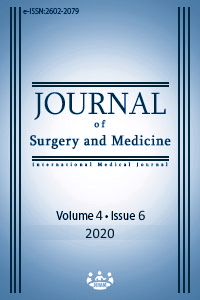Effects of heparin and prednisolone on postoperative intra-abdominal adhesions in Wistar rats
Keywords:
Anima models, Heparin, Postoperative intra-abdominal adhesionsAbstract
Aim: Postoperative intra-abdominal adhesions are one of the complications surgeons want to avoid. It was aimed to compare the effects of physiological saline, heparin, Ringer’s lactate, and prednisolone, which have been commonly used for surgical adhesions, with repeated lavage on postoperative adhesions.
Methods: Upon the approval of the Ethics Committee of Fırat University, Faculty of Medicine, 35 Wistar Albino (female) rats were randomized into 5 groups (Heparin BID, Heparin QD, Prednisolone QD, Prednisolone BID, and Control) of 7 rats, and adhesion was created with peritoneal injury model in all rats. The differences in the adhesions created between groups were compared using the macroscopic adhesion scoring system of Linsky.
Results: No significant differences were found between physiological saline-heparin and Ringer's lactate-prednisolone groups in terms of adhesion scores (P=0.06). There was a difference in adhesion severity on the left only in the groups receiving heparin QD and prednisolone QD (P=0.04).
Conclusion: We demonstrated that none of the agents (Physiological saline, Heparin, Ringer's lactate, and prednisolone) we used in our study model reduced adhesions. It is thought that no difference was detected because of the adhesion model we established. Advanced technology-based studies are still needed to prevent postoperative intra-abdominal adhesions that are globally observed to reduce a huge economic burden and decrease mortality and morbidity.
Downloads
References
Arung W, Meurisse M, Detry O. Pathophysiology and prevention of postoperative peritoneal adhesions. World J Gastroenterol. 2011 Nov 7;17(41):4545-53. doi: 10.3748/wjg.v17.i41.4545.
Esposito AJ, Heydrick SJ, Cassidy MR, Gallant J, Stucchi AF, Becker JM. Substance P is an early mediator of peritoneal fibrinolytic pathway genes and promotes intra-abdominal adhesion formation. J Surg Res. 2013 May 1;181(1):25-31. doi: 10.1016/j.jss.2012.05.056.
Hesselman S, Högberg U, Råssjö EB, Schytt E, Löfgren M, Jonsson M. Abdominal adhesions in gynaecologic surgery after caesarean section: a longitudinal population-based register study. BJOG. 2018 Apr;125(5):597-603. doi: 10.1111/1471-0528.14708.
Farag S, Padilla PF, Smith KA, Sprague ML, Zimberg SE. Management, Prevention, and Sequelae of Adhesions in Women Undergoing Laparoscopic Gynecologic Surgery: A Systematic Review. J Minim Invasive Gynecol. 2018 Nov - Dec;25(7):1194-216. doi: 10.1016/j.jmig.2017.12.010.
Schnüriger B, Barmparas G, Branco BC, Lustenberger T, Inaba K, Demetriades D. Prevention of postoperative peritoneal adhesions: a review of the literature. Am J Surg. 2011;201:111-21.
Yeo Y, Highley GB, Bellas E, Ito T, Marini R, Kohane S. In Situ Crosslinkable hyaluronic acid hydrogels prevent post-operative abdominal adhesions in a rabbit model. Biomaterials. 2006;27:4698-705.
Bragg D, El-Sharkawy AM, Psaltis E, Maxwell-Armstrong CA, Lobo DN. Postoperative ileus: Recent developments in pathophysiology and management. Clin Nutr. 2015 Jun;34(3):367-76. doi: 10.1016/j.clnu.2015.01.016.
Thomas M, van der Poel AFB. Physical quality of pelleted animal feed 1. Criteria for pellet quality, Animal Feed Science and Technology. 1996;61(1–4);89-112. doi:.10.1016/0377-8401(96)00949-2.
Linsky CB, Diamond MP, Cunningham T, Constantine B, DeCherney AH, diZerega GS. Adhesion reduction in the rabbit uterine horn model using an absorbable barrier, TC-7. J Reprod Med. 1987 Jan; 32(1):17-20.
Norrbom C, Steding-Jessen M, Agger CT, Osler M, Krabbe-Sorensen M, Settnes et al. Risk of adhesive bowel obstruction after abdominal surgery. A national cohort study of 665,423 Danish women Am J Surg. 2019 Apr;217(4):694-703. doi: 10.1016/j.amjsurg.2018.10.035.
Yan S, Yue YZ, Zeng L, Yue J, Li WL, Mao CQ, et al. Effect of intra-abdominal administration of ligustrazine nanoparticles nano spray on postoperative peritoneal adhesion in rat model. J Obstet Gynaecol Res. 2015 Dec;41(12):1942-50. doi: 10.1111/jog.12807.
Zong X, Li S, Chen E, Garlick B, Kim KS, Fang D, et al. Prevention of postsurgery-induced abdominal adhesions by electrospun bioabsorbable nanofibrous poly(lactide-coglycolide)-based membranes. Ann Surg. 2004;240(5):910–5.
Abu-Elhasan AM, Abdellah MS, Hamed HO. Safety and efficacy of postoperative continuous intra-peritoneal wash with lactated Ringer's for minimizing post-myomectomy pelvic adhesions: a pilot clinical trial. Eur J Obstet Gynecol Reprod Biol. 2014 Dec;183:78-82. doi:10.1016/j.ejogrb.2014.09.002.
Falk K, Holmadhl L. Foreign materials. In: DiZerega GS, editor. Peritoneal Surgery. New York: Springer-Verlag, 2000:153-174.
Brüggmann D, Tchartchian G, Wallwiener M, Münstedt K, Tinneberg HR, Hackethal A. Intra-abdominal adhesions: definition, origin, significance in surgical practice, and treatment options. Dtsch Arztebl Int. 2010 Nov;107(44):769-75. doi: 10.3238/arztebl.2010.0769.
Api M, Cikman MS, Boza A, Rabus MB, Onenerk M, Aker FV. Peritoneal closure over barbed suture to prevent adhesions: a randomized controlled trial in an animal model. J Minim Invasive Gynecol. 2015 May-Jun;22(4):619-25. doi: 10.1016/j.jmig.2015.01.013.
Li L, Wang N, Jin X, Deng R, Nie S, Sun L, et al. Biodegradable and injectable in situ cross-linking chitosan-hyaluronic acid based hydrogels for postoperative adhesion prevention. Biomaterials. 2014 Apr;35(12):3903-17. doi: 10.1016/j.biomaterials.2014.01.050.
Chiorescu S, Andercou OA, Grad NO, Mironiuc IA. Intraperitoneal administration of rosuvastatin prevents postoperative peritoneal adhesions by decreasing the release of tumor necrosis factor. Clujul Med. 2018;91(1):79-84. doi: 10.15386/cjmed-859.
Dokur M, Uysal E. Evaluation of botulinum toxin type A effectiveness in preventing postoperative intraperitoneal adhesions. Ann Surg Treat Res. 2017 Jul;93(1):50-6. doi: 10.4174/astr.2017.93.1.50. Epub 2017 Jun 26.
Makarchian HR, Kasraianfard A, Ghaderzadeh P, Javadi SM, Ghorbanpoor M. The effectiveness of heparin, platelet-rich plasma (PRP), and silver nanoparticles on prevention of postoperative peritoneal adhesion formation in rats. Acta Cir Bras. 2017 Jan;32(1):22-7. doi: 10.1590/s0102-865020170103.
Ural DA, Sarıhan H, Saygın İ, Aykan DA, Ural A, İmamoglu M. Long-term outcomes of pure olive oil to prevent postoperative peritoneal adhesions in rats. J Surg Med. 2019;3(3):218-22.
Downloads
- 619 1085
Published
Issue
Section
How to Cite
License
Copyright (c) 2020 Caner Çakır, Erhan Okuyan, Betül Tokgöz, Gokhan Karakoc, Enis Ozkaya, Tuncay Kucukozkan
This work is licensed under a Creative Commons Attribution-NonCommercial-NoDerivatives 4.0 International License.
















